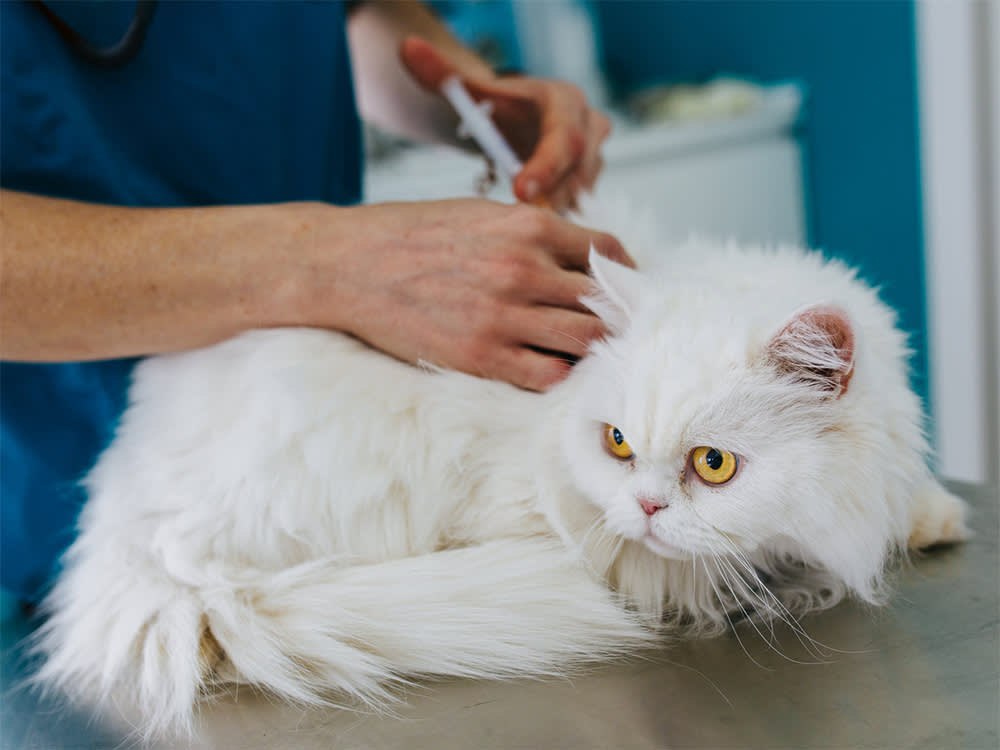What to Know About Rabies in Cats
There is one way to make sure your cat stays safe: vaccinate, vaccinate, vaccinate.

share article
Rabies occupies a big space in popular culture. Whether it’s terrifying us in Cujo or making us weep in Old Yeller, it looms large as a dramatic, unstoppable disease that ravages its host. Despite its potential to entertain and frighten us, it is a real disease that can cause big problems for anything exposed to it.
Cats aren’t usually portrayed as a host of this deadly virus, but they are one of the many animals that can be affected by it. It’s important to know how to prevent rabies in cats, the symptoms a rabid animal will show, and what to do if your cat gets bitten by another animal.
What Is Rabies and How Does It Infect Cats?
Rabies is a virus that occurs throughout most of the world. Some countries (mostly islands) have managed to eliminate the virus and need to maintain strict animal import controls to prevent reintroduction of the virus into their ecosystem. Any warm-blooded animal can be infected by the rabies virus. Some animals, including birds and opossums, have a high natural resistance to rabies, while others, such as foxes, wolves, and some rodents, are more susceptible.
Cats are moderately susceptible to rabies. By far, the most common way for rabies to infect a cat is through a bite from an infected animal. Rarely, rabies can be spread by infected saliva or neural material contacting open wounds or mucous membranes.
After a bite, the virus spreads from the wound to local nerves. Once it reaches the nerves, it moves up to four inches per day toward the central nervous system (CNS is the brain and spinal cord). It begins to spread much more rapidly after infecting the CNS. It can take a long time for the infection to show up if the bite is far from the CNS. It can take up to six months in some cases, though most cats begin to show symptoms within a month or two of a bite.
How Do Rabid Animals Act?
Once the virus reaches the CNS, it spreads out to the rest of the nerves in the body and to the salivary glands. In most cases, the virus begins to shed in the saliva before symptoms appear, allowing infected animals to spread the disease.
Rabies is typically described in three phases. There is often what is referred to as a prodromal phase before severe symptoms appear. In this phase, the animal is often anxious and may gnaw at the area where the bite occurred. This phase can last two to three days.
The furious phase is usually what’s shown in movies. Some animals never enter this phase, so the classic aggressive, frantic biting frenzy is not always a part of the disease. Despite the depictions in movies, dogs go through this phase less frequently than cats do. Signs seen in this phase include:
Unprovoked aggressionopens in a new tab
Snapping at unseen objects (called fly-biting)
Seizures
Loss of coordination
Disorientation
Abnormal behavior
Death
The paralytic phase (also called “dumb rabies”) is often the final phase of the disease. Animals showing paralytic symptoms often cannot swallow, which can cause droolingopens in a new tab (foaming at the mouth), inability to eatopens in a new tab, and fear of water. The limb that was bitten usually becomes paralyzed first, followed by general paralysis. Animals will develop difficulty breathing, seizures, and eventually become comatose. Rabies is fatal, and death generally occurs within 10 days of the onset of symptoms.
How Common Is Rabies in Cats?
In the United States, cats are the most commonly affected domesticated species. 216 cats tested positive for rabies in 2021. This accounted for almost 70 percent of the cases opens in a new tabin domestic animals that year. Other commonly affected domestic species include dogs, cows, and horses.
What Can Be Done to Prevent Rabies in Cats?
Rabies in cats can be prevented easily with vaccination. Rabies vaccination is simple, affordable, and effective. Cats should be (and in most areas of the U.S. are legally required to be) vaccinated as kittens. A veterinarian will determine the schedule, but cats as young as 12 weeks of age can be vaccinated against rabies. They should be vaccinated again one year later. Vaccinations after that will occur every one to three years, depending on the type of vaccineopens in a new tab and local laws.
Minimizing contact with wildlife is also an important part of prevention. Cats should be kept indoors to prevent them from finding trouble. Always avoid contact with wild animals, especially common reservoir hosts for the virus like bats, skunks, raccoons, weasels, foxes, and meerkats. Any animal that is acting abnormally (like a raccoon that is out during the daytime) should be given a wide berth and reported to your local Animal Control office.
Cats need veterinary care as soon as possible if they encounter a bat or are bitten by an unknown or unvaccinated animal. A vaccine booster and monitoring will likely be recommended in addition to any care necessary for their wounds.
Can a Cat with Rabies Infect a Human?
Yes, any animal infected with rabies can spread it to a human or another animal. Most cases in humans in the U.S. come from contact with batsopens in a new tab. It is important to report any possible human or animal contact with a bat to health authorities, even if no bite or scratch is visible. This will allow post-exposure prophylaxis (PEP) to be started. PEP is very effective at preventing rabies from developing since the virus moves so slowly through the nervous system.
In the U.S., rabies spread to humans is very low due to effective control of canine rabies. There were five cases in the US in 2021, which was an unusually high numberopens in a new tab. Unfortunately, rabies is more common in humans in other areas of the globe, with over 59,000 deaths occurring annually. The overwhelming majority of these cases are caused by dog bitesopens in a new tab.
Can Rabies in Cats Be Treated?
Rabies is uniformly fatal in animals once symptoms arise. Because of the suffering involved and concerns about the safety of people and other animals, euthanasia of animals suspected of having rabies is recommended. Even in humans, survival after symptoms begin is almost unheard of. The only good solution for rabies is prevention.

Dr. Bartley Harrison, DVM
Dr. Bartley Harrison, DVM is a small animal veterinarian based in North Carolina who has practiced emergency medicine since graduating from the Texas A&M College of Veterinary Medicine. His primary interest areas include pain management, cardiology, and the treatment of shock.
He is a member of the Veterinary Emergency and Critical Care Society, American Veterinary Medical Association, and American Medical Writers Association. In addition to his clinical work, he writes pet health articles to help provide accurate information for both new and experienced pet parents. When he’s not working, he enjoys cooking, traveling, reading, and going on adventures with his dog.
Related articles
![Kitten sitting on a blanket]() opens in a new tab
opens in a new tab7 Steps to Keep Your New Kitten Happy and Healthy
With great cuteness comes great responsibility. A vet breaks down everything you need to know when you bring home a new kitten.
![Brown Labrador lifting front leg]() opens in a new tab
opens in a new tabHow to Get a Head Start on Your Pet’s Health
Spot lumps, limps, and lethargy early on.
![Profile view of a man giving a cat food to eat]() opens in a new tab
opens in a new tabWhy Is My Cat Not Eating? Causes, Symptoms, and Treatment
A veterinary nutritionist explains why your cat isn’t eating and how to increase their appetite.
![Person with short hair putting water bowl on floor for cat]() opens in a new tab
opens in a new tabHow to Get a Cat to Drink Water
Their desert-dwelling roots might resist hydration, but these tricks can help.
![Person holding a mix breed dog talking to veterinarian about their concerns.]() opens in a new tab
opens in a new tab8 Things Your Veterinarian Wishes You Wouldn’t Do
Common vet pet peeves, if you will.








